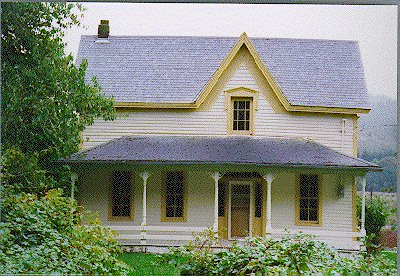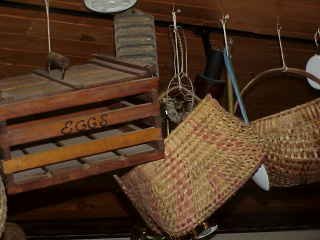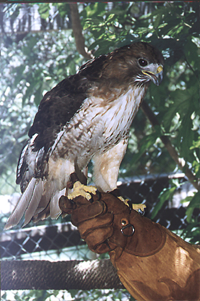|
Strike Axe was a family
name of an Osage family. Their genealogy is tied in with the Jones's
through Dora Strike Axe. This property was purchased and it was separate
from the allotment of Bertha Big Eagle where Dennis Jones built the
Bungalow style house. This is the home where Lee Otis Jones, and Velma
Louise Penseneau Jones lived. Lee Otis, my father, was a brother to Dennis
Jones, and a son of Joseph Hubbard Jones, grandson of William Stevens
Jones.

Here is a picture similar to the Strike Axe
The Strike Axe place was an
older home and it was rich with the established landscaping the original
tenants had put there. The beautiful old trees were what made it so
pleasant.
There was a fenced yard
also. A cement cellar set immediately off the large cement back porch.
This is all that remains there today. The house burned around 1988. It was
an eyesore to the people who lived below it in that it could be seen right
out of their kitchen window. They were probably, glad to see it go. I wish
now I had picked up some of the things left there by my family, the old
sewing machine base, the medal bed frame backboards, some of the toys we
children had, other little things like this. The house was only a mile
from Dennis and Bertha's home. Lee and Velma were homebodies and kept an
eye on Dennis's home since they were gone most of the time.
Velma loved to garden,
raise chickens, sew, can, quilt and she loved people and company. A lot of
time was spent in entertaining. This out of the way place served as a
retreat to many city folks who were happy to come fish in the watershed
Lee built. Sometimes, they were invited to come share the late crops of
Velma's garden and they enjoyed this too. When I say garden, actually, it
was more like farming. She would have two acres of pop corn, maybe five
acres of maize, two or three acres of corn for canning, a very large bed
of strawberries, maybe a fourth of an acre. Velma was gifted with the
genes and intellect of a farmer and she had a built in sense of planting
crops at the right time.

wooden egg crate
Those were the days before
clear plastic wraps but she bought the newer cellophane bags to bag up her
dried foods such as beans, corn, soybeans, popcorn, etc. This extra
produce she took to town on market days and traded for dry goods we
needed. The crates of eggs she took into town were grabbed up by the
grocer there. Her hand work, such as pillow cases edged in crochet work
were always purchased by individuals. She had a sense of fair pricing
which allowed her a profit but was shared with people so they could afford
to buy. The feed then was sold in pattern fabric as sacks. These were
essentially free and it was what she used to make plain things. Nicer
pillow cases and scarves she used a good quality of white woven cotton
which sewed up to look very fine, especially with her lovely hand work on
it.
This picture is similar to
the Strike Axe except the pillars on the front were about one and a half
foot square built. This made the difference is how much more attractive it
was.
The barn setting to one
side of the house was large. It had a granary where grain was stored. That
room was probably about nine by twelve feet. There was a window setting
high and this is where the grain chute was used.
The little prairie
rattlesnakes were a fear for Velma. We could not go out before she let
the dog run around the fence line. If we picked strawberries we had to
take a stick with us and poke around the bushes before we reached down to
them.
Velma kept a chicken
incubator in one room of the chicken house. This was where she hatched
eggs and kept baby chicks during the winter when it was cold. She also
always had setting hens. This is a pleasant memory as I can still see the
little chicks running under their mother's feathers when it rained. What a
beautiful concept and way to teach a child, I'm reminded.
Coyotes, civet cats,
skunks, weasels, and chicken hawks were a constant threat to Velma's
chickens. Lee taught her how to use a shot gun and I can see her yet,
blasting away at a low flying hawk as it attempted to pick up one of her
juicy fat hens.

Picture of a "Chicken Hawk" which is in
reality a red tailed Hawk
She loved to tell the story
about how she pulled off her dress to run out to grab the mother hen and
chicks caught in a sudden down pour. A neighboring rancher just happened
to be on his horse looking for a stray. She screamed and literally dived
into her corn patch for cover.
Velma was American Indian
and her unity with the elements was noteworthy. It didn't bother her a bit
to stand under the eves of the house to wash her hair in the water running
off. The mineral free rainwater, fresh, was a bonus to make her
shimmering long black hair even more striking.
Only now, sixty years
later, can I see the circumstances to cause a break between the
brothers which had nothing to do with their own personal lives. To cause
the loss of all things good and beautiful itself was brought about by
forces up above which had to do with the greed of those so accustomed to
siphoning off the wealth of the Osage. The squeeze was too much for the
small rancher to absorb with the death of Bertha and her loss.
No regrets. It was a
wonderful beginning for my life and there is no loss there. |

